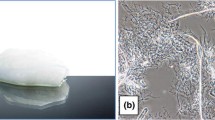Abstract
In recent years, about 10% of the total wastes generated around the world were fabric wastes and, due to the large volume of these wastes, should be well managed. Among the various types of fabrics, some have greater biodegradability and can be decomposed at the acceptable rates under controlled conditions. In this study, the disintegration of linen fabric was investigated under composting conditions. During the composting process, temperature, moisture, and aeration were controlled. According to FTIR spectra of linen fabrics during the composting process, the disintegration of linen fibers was identified as the breakdown of carbonyl groups and hydrogen bonds of cellulosic chains. Regarding the SEM images of linen fabrics, the composting process in the first 45 days led to the breakdown of the fibers, and in the second 45 days of the process, most of the fibers were degraded. Since in the second 45 days of the process, the compost pile temperature is always between 39 and 44 °C and 65–70 °C, it can be concluded that the rate of microbial disintegration of the linen fabric is higher at these temperatures. At the end of the test, the disintegration value of the linen fabric was 55% and the weight loss due to organic matter conversion was 61%. The samples weight loss showed that linen fabric has high biodegradability under composting conditions. The germination index (GI) of the resulting compost was 73.88%, which indicates the produced compost is mature.







Similar content being viewed by others
References
Adams RC, Maclean ES, Dixon JK, Bennett EM, Martin GL, Lough RC (1941) Second interim report of the interdepartmental committee on utilization of organic wastes. N Z Eng 6:12
Agarwal PK (2005) Role of protein dynamics in reaction rate enhancement by enzymes. J Am Chem Soc 127(43):15248–15256
Arshad K, Skrifvars M, Vivod V, Valh J, Voncina B (2014) Biodegradation of natural textile materials in soil. Tekstilec 57(2):118–132
Barrena R, Artola A, Vázquez F, Sánchez A (2009) The use of composting for the treatment of animal by-products: experiments at lab scale. J Hazard Mater 161(1):380–386
Behera AK, Avancha S, Basak RK, Sen R, Adhikari B (2012) Fabrication and characterizations of biodegradable jute reinforced soy based green composites. Carbohydr Polym 88(1):329–335
Bhat G, Parikh D (2010) Biodegradable materials for nonwovens. Applications of nonwovens in technical textiles :46–61
Desai AJ, Pandey SN (1971) Microbial degradation of cellulosic textiles. J Sci Indus Res 30:598–606
EN 14806 (2005) Packaging- preliminary evaluation of the disintegration of packaging materials under simulated composting conditions in a laboratory scale test. BSI
Epstein E (2011) Industrial composting: environmental engineering and facilities management. CRC Press
Gigliotti G, Proietti P, Said-Pullicino D, Nasini L, Pezzolla D, Rosati L, Porceddu PR (2012) Co-composting of olive husks with high moisture contents: organic matter dynamics and compost quality. Int Biodeterior Biodegrad 67:8–14
Hu Z, Lane R, Wen Z (2009) Composting clam processing wastes in a laboratory-and pilot-scale in-vessel system. Waste Manag 29(1):180–185
Kavkler K, Demsar A (2012) Application of FTIR and Raman spectroscopy to qualitative analysis of structural changes in cellulosic fibres. Tekstilec 55(1):19–31
Klemenčič D, Simončič B, Tomšič B, Orel B (2010) Biodegradation of silver functionalised cellulose fibres. Carbohydr Polym 80(2):426–435
Kopčić N, Domanovac MV, Kučić D, Briški F (2014) Evaluation of laboratory-scale in-vessel co-composting of tobacco and apple waste. Waste Manag 34(2):323–328
Kumar M, Ou YL, Lin JG (2010) Co-composting of green waste and food waste at low C/N ratio. Waste Manag 30(4):602–609
Kuok F, Mimoto H, Nakasaki K (2012) Effects of turning on the microbial consortia and the in situ temperature preferences of microorganisms in a laboratory-scale swine manure composting. Bioresour Technol 116:421–427
Lashermes G, Barriuso E, Le Villio-Poitrenaud M, Houot S (2012) Composting in small laboratory pilots: performance and reproducibility. Waste Manag 32(2):271–277
Li L, Frey M, Browning KJ (2010) Biodegradability study on cotton and polyester fabrics. J Eng Fabr Fiber 5(4)
Mohanty AK, Khan MA, Hinrichsen G (2000) Surface modification of jute and its influence on performance of biodegradable jute-fabric/biopol composites. Compos Sci Technol 60(7):1115–1124
Müller R J (2005) Biodegradability of polymers: regulations and methods for testing. Biopolymers online
Park CH, Kang YK, Im SS (2004) Biodegradability of cellulose fabrics. J Appl Polym Sci 94(1):248–253
Petric I, Šestan A, Šestan I (2009) Influence of initial moisture content on the composting of poultry manure with wheat straw. Biosyst Eng 104(1):125–134
Rudnik E (2010) Compostable polymer materials. Elsevier
Salerno-Kochan R, Szostak-Kotowa J (2001) Biodegradation of cellulose textiles. Fibres Text East Eur 9(3):69–72
Sun ZY, Zhang J, Zhong XZ, Tan L, Tang YQ, Kida K (2016) Production of nitrate-rich compost from the solid fraction of dairy manure by a lab-scale composting system. Waste Manag 51:55–64
Sundberg C, Yu D, Franke-Whittle I, Kauppi S, Smårs S, Insam H, Jönsson H (2013) Effects of pH and microbial composition on odour in food waste composting. Waste Manag 33(1):204–211
Tomšič B, Simončič B, Orel B, Vilčnik A, Spreizer H (2007) Biodegradability of cellulose fabric modified by imidazolidinone. Carbohydr Polym 69(3):478–488
Warnock M, Davis K, Wolf D, Gbur E (2009) Biodegradation of three cellulosic fabrics in soil. Summ Ark Cotton Res:208–211
Zucconi F, Pera A, Forte M, De Bertoldi MARC (1981) Evaluating toxicity of immature compost. BioCycle (USA) 22:54–57
Author information
Authors and Affiliations
Corresponding author
Additional information
Responsible editor: Philippe Garrigues
Rights and permissions
About this article
Cite this article
Esmaeilzadeh, MJ., Rashidi, A. Evaluation of the disintegration of linen fabric under composting conditions. Environ Sci Pollut Res 25, 29070–29077 (2018). https://doi.org/10.1007/s11356-018-2917-y
Received:
Accepted:
Published:
Issue Date:
DOI: https://doi.org/10.1007/s11356-018-2917-y




